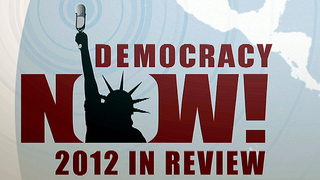
By Amy Goodman and Denis Moynihan
DOHA, Qatar—The 18th U.N. climate-change summit is taking place in the small but immensely wealthy Gulf emirate of Qatar, the largest per capita emitter of greenhouse gases in the world. Delegates, press, dignitaries and the legions of low-paid, foreign guest workers here at the opulent Qatar National Convention Center all pass under an enormous spider, a 30-foot-high cast-bronze statue called “Maman,” by the French-American sculptor Louise Bourgeois. It was chosen by the emir’s wife, and snapped up for a reported $10 million. The Obama administration has been accused, rightly, of derailing the UN climate negotiations in recent years, which makes the spider an appropriate symbol, as famously described by the lines from an 1808 poem by Sir Walter Scott,
“Oh! what a tangled web we weave
When first we practice to deceive!”
Here at the summit, referred to as the COP 18 (18th Conference of Parties), I met up with climate scientist Bill Hare, one of the lead authors of a new World Bank report, “Turn Down the Heat: Why a 4 Degree C Warmer World Must Be Avoided.” With the U.S. media focused on the so-called fiscal cliff, I asked Hare how the world’s historically largest emitter of greenhouse gases, the United States, could be expected to contribute to a global fund to combat climate change:
“We have a climate cliff. … We’re facing a carbon tsunami, actually, where huge amounts of carbon are now being emitted at a faster rate than ever. And it’s that carbon tsunami that’s likely to overwhelm the planet with warming, sea-level rise and acidifying the oceans.”
Just a day after I interviewed Hare, a powerful typhoon hit the Philippines. I spoke with the lead climate negotiator from the Philippines, Naderev Sano, just minutes after the news of the typhoon broke. “It is sobering for us to know that a typhoon like this normally doesn’t hit that part of the country,” he told me. “In half a century, this is the first time that a typhoon that has crossed as far south as Bopha has.” I asked Sano what he was hoping for in Doha:
“The single biggest measure of success in Doha is, first and foremost, the second commitment period of the Kyoto Protocol. That is something we hold very dearly, because that is the jump-off base for enhanced ambition for the whole world.”
The Kyoto Protocol is the only legally binding global treaty that forces nations to reduce greenhouse-gas emissions. Unless action is taken, it will lapse at the end of this month. Sano explained: “When we reach the first day of 2013, if we don’t have any success here in Doha, then we end up with nothing. We end up with a … system where climate change faces a world that has not found the political will to address the climate crisis.”
Another participant at the summit is Kumi Naidoo, the executive director of Greenpeace International. I last interviewed him via phone as he was hanging from a Russian Gazprom oil rig in the Arctic, getting hosed down with water intended to dislodge him. Naidoo wrote before coming to COP 18: “Doha is already infamous for dead-end trade talks. One more failure and it will be forever known as the place where global deals go to die.”
At a press conference held here, Naidoo directed his own rhetorical fire hose at the Obama administration. Noting Barack Obama’s reference to climate change in his Nov. 6 victory speech, Naidoo said, naming Obama’s climate negotiators, “Todd Stern and Jonathan Pershing have come to Doha with their needle stuck in the groove of obstructing the U.N. process, an art they have perfected. It is disrespectful of President Obama to inflict on us two negative negotiators who act as if the comments he made after his election were never made. He should either pick up the phone and tell his delegates to follow his lead or alternatively call them back to Washington.” When I asked Pershing to respond to Naidoo, whether he was following President Obama’s wishes, he replied, “No comment.”
While the expectations for the Doha climate summit are low, even grim, and while attendance at this summit is a fraction of what we saw at the last three in Copenhagen, Cancun and Durban, there is here a strong core of committed people who care about the future of the planet, who are taking action to protect it from human-induced climate change. It is these people who the giant spider in the lobby also represents. The sculpture is protecting a sac of eggs, and, as Louise Bourgeois explained: “The Spider is an ode to my mother. … Like a spider, my mother was a weaver. Spiders are helpful and protective.”
From Typhoon Bopha in the Philippines to Superstorm Sandy in the United States, the web of climate activists is not tangled, but growing stronger, leading the way. If only the politicians would follow.
© 2012 Amy Goodman











Media Options